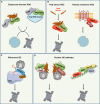Repair or destruction-an intimate liaison between ubiquitin ligases and molecular chaperones in proteostasis
- PMID: 28699655
- PMCID: PMC5601288
- DOI: 10.1002/1873-3468.12750
Repair or destruction-an intimate liaison between ubiquitin ligases and molecular chaperones in proteostasis
Abstract
Cellular differentiation, developmental processes, and environmental factors challenge the integrity of the proteome in every eukaryotic cell. The maintenance of protein homeostasis, or proteostasis, involves folding and degradation of damaged proteins, and is essential for cellular function, organismal growth, and viability . Misfolded proteins that cannot be refolded by chaperone machineries are degraded by specialized proteolytic systems. A major degradation pathway regulating cellular proteostasis is the ubiquitin (Ub)/proteasome system (UPS), which regulates turnover of damaged proteins that accumulate upon stress and during aging. Despite a large number of structurally unrelated substrates, Ub conjugation is remarkably selective. Substrate selectivity is mainly provided by the group of E3 enzymes. Several observations indicate that numerous E3 Ub ligases intimately collaborate with molecular chaperones to maintain the cellular proteome. In this review, we provide an overview of specialized quality control E3 ligases playing a critical role in the degradation of damaged proteins. The process of substrate recognition and turnover, the type of chaperones they team up with, and the potential pathogeneses associated with their malfunction will be further discussed.
Keywords: CHIP; E3 ligase; aging; chaperone; proteostasis; quality control; ubiquitin.
© 2017 The Authors. FEBS Letters published by John Wiley & Sons Ltd on behalf of Federation of European Biochemical Societies.
Figures


Similar articles
-
Molecular chaperones in targeting misfolded proteins for ubiquitin-dependent degradation.FEBS J. 2012 Feb;279(4):532-42. doi: 10.1111/j.1742-4658.2011.08456.x. Epub 2012 Jan 4. FEBS J. 2012. PMID: 22177318 Review.
-
Distinct proteostasis circuits cooperate in nuclear and cytoplasmic protein quality control.Nature. 2018 Nov;563(7731):407-411. doi: 10.1038/s41586-018-0678-x. Epub 2018 Oct 31. Nature. 2018. PMID: 30429547 Free PMC article.
-
Cooperation of a ubiquitin domain protein and an E3 ubiquitin ligase during chaperone/proteasome coupling.Curr Biol. 2001 Oct 16;11(20):1569-77. doi: 10.1016/s0960-9822(01)00487-0. Curr Biol. 2001. PMID: 11676916
-
A protein quality control pathway at the mitochondrial outer membrane.Elife. 2020 Mar 2;9:e51065. doi: 10.7554/eLife.51065. Elife. 2020. PMID: 32118579 Free PMC article.
-
UPS-dependent strategies of protein quality control degradation.Trends Biochem Sci. 2024 Oct;49(10):859-874. doi: 10.1016/j.tibs.2024.06.006. Epub 2024 Jun 29. Trends Biochem Sci. 2024. PMID: 38945729 Review.
Cited by
-
Comparative modeling and mutual docking of structurally uncharacterized heat shock protein 70 and heat shock factor-1 proteins in water buffalo.Vet World. 2019 Dec;12(12):2036-2045. doi: 10.14202/vetworld.2019.2036-2045. Epub 2019 Dec 23. Vet World. 2019. PMID: 32095057 Free PMC article.
-
CHIPped balance of proteostasis and longevity.Oncotarget. 2017 Oct 27;8(57):96472-96473. doi: 10.18632/oncotarget.22101. eCollection 2017 Nov 14. Oncotarget. 2017. PMID: 29228542 Free PMC article. No abstract available.
-
E3 Ubiquitin Ligase APC/CCdh1 Regulation of Phenylalanine Hydroxylase Stability and Function.Int J Mol Sci. 2020 Nov 28;21(23):9076. doi: 10.3390/ijms21239076. Int J Mol Sci. 2020. PMID: 33260674 Free PMC article.
-
Development of flow cytometry assays for measuring cell-membrane enzyme activity on individual cells.J Cancer. 2020 Jan 1;11(3):702-715. doi: 10.7150/jca.30813. eCollection 2020. J Cancer. 2020. PMID: 31942194 Free PMC article.
-
Proteome Instability Is a Therapeutic Vulnerability in Mismatch Repair-Deficient Cancer.Cancer Cell. 2020 Mar 16;37(3):371-386.e12. doi: 10.1016/j.ccell.2020.01.011. Epub 2020 Feb 27. Cancer Cell. 2020. PMID: 32109374 Free PMC article.
References
Publication types
MeSH terms
Substances
Grants and funding
LinkOut - more resources
Full Text Sources
Other Literature Sources

